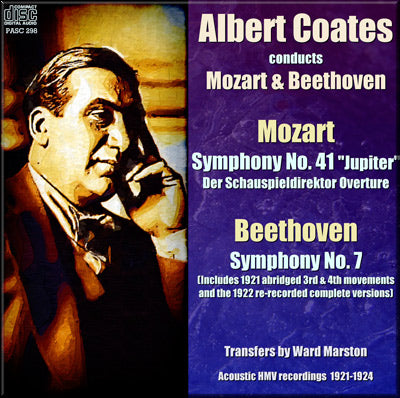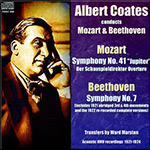
This album is included in the following sets:
This set contains the following albums:
- Producer's Note
- Full Track Listing
- Cover Art
- Historic Review
Albert Coates - complete Mozart 'Jupiter' and Beethoven 7th
Rare acoustic recordings in excellent new transfers by Ward Marston
Untangling the Beethoven Symphony No. 7 issues
For this reissue, I transferred the six sides of 1921 from the Victor issue, and the 1922 remakes of movements 3 and 4 from the French W series issue:
Movement I: 25 October 1921; (Cc589-1, Cc590-2) assigned HMV catalogue number D604 but only published on Victor 55165 and later on French HMV W437.
Movement II: 25 October 1921; (Cc591-2, Cc592-2) assigned HMV catalogue number D605 but only published on Victor 55166 and later on French HMV W438.
Movement III (abridged): 25 October 1921; (Cc593-1); assigned HMV catalogue number D606 but only published on Victor 55173.
Movement IV (abridged): 28 October 1921; (Cc605-3) assigned HMV catalogue number D606 but only published on Victor 55173.
Remakes of 3rd and 4th movements, each complete on 2 sides:
Movement III: 17 November 1922; (Cc2166-2, Cc2167-2) assigned HMV catalogue number D927 but only published on French HMV W480.
Movement IV: 17 November 1922; (Cc2168-2, Cc2169-2) assigned HMV catalogue number D928 but only published on French HMV W481.
The HMV files give assigned D series numbers to both recordings as I have indicated, but I don't think they were ever issued. The 1921 six sided version of the symphony was issued on blue label Victor 55165 55166 and 55174. In 1924, HMV planned to issue the first 2 movements from 1921, along with the remakes of the 3rd and 4th movements. It was never issued in England, but years ago, I discovered quite by accident having found a copy, that French HMV had issued it on W 437, 438, 480, and 481.
Ward Marston
-
MOZART - Symphony No. 41 in C, K.551 "JUPITER"
Recorded 27 August and 16 October 1923
Issued on HMV D942-45
-
MOZART - Der Schauspieldirektor, K486 - Overture
Recorded 22 & 24 October 1924
Issued on HMV D951-952
-
BEETHOVEN - Symphony No. 7 in A, Op. 92
Recorded 25 & 28 October 1921
Issued on Victor 55165, 55166, 55173
3 & 4 re-recorded 17 November 1922
Issued on French HMV W480, W481
The Symphony Orchestra
Albert Coates, conductor
(Credited to The Symphony Orchestra, probably members of London Symphony Orchestra)
Transfers by Ward Marston
Cover artwork based on a photograph of Albert Coates
Total duration: 70:41
Review of Mozart discs, 1925:
"A
correspondent has reproved me for my temerity in attributing great
virtues to symphonies of Mozart and Brahrns in a recent review. He
approves my remarks on the Mozart work, but suggests I have taken leave
of my senses in allowing that there is any beauty in the Brahms. When
his musical education has passed beyond the elementary stage he will
discover that one does notexalt one composer at the expense of another :
that one must cultivate the historical sense and understand a
composer's relation to his time, the effect of environment upon him, and
so forth finally that the whole art of music is one's kingdom and not
any one state in it. My correspondent may be surprised to learn that
there are people who regard Moz,art's music as fussy and superficial.
Here, in addition to a lack of perception, is also a lack of the
historical sense. Mozart was no revolutionary ; he adopted many of the
conventions of his time, as a study, for instance, of his piano sonatas
will prove. Even in his greatest works passages sometimes occur which
are merely eighteenth century platitudes ; but it would be ridiculous to
decry his music on that account. Appreciation, as has often been said,
is criticism ; criticism is not faultfinding, but an estimate based on a
knowledge of all the facts.
A long preamble to Mozart's
so-called Jupiter Symphony in C major—the last of the " big three " ! It
is a graceful tribute to Mozart that the premier companies have
contributed each one apiece. Let us recall the substance of what Jahn
says of these three masterpieces : " The first is a triumph of beauty in
sound, the second a work of art exhausting its topic, and the third is
in more than one respect the greatest and noblest of the symphonies."
The work we are considering is of an epic character compared to the
others ; there is an Olympian stride in the very first bars, followed by
a quietly tender passage. Here is a formula - -fortepiano—which marks
music of this century, but Mozart infuses rich life into the convention ;
on the other hand, the quickly reached dominant cadence seems as
platitudinous as Handel's descending scales ; but wait awhile. After the
pause it is a delight to follow Mozart's treatment of his theme and
recognise with joy the delicate wood-wind elaborations he contrives. The
second tune gives an opportunity for the bassoon to join in with the
first violins. A sudden outburst on a chord of C minor, after a silent
bar, is unexpected and doubtless agitated the conservatives of the
period. The music derives from the opening bars and the stress is
maintained up to the double bar, after which a repeat is made. When this
is passed Mozart gently lifts us out of the key of G into that of E
flat, extending the ideas recently heard through some enchanting
modulations and wood-wind colours. The striding figure of the opening
bars dominates the music, firmly leading it back to the recapitulation.
This time the oboe joins the bassoon and first violins in the
delineation of the second tune. The tonic and dominant end justifies
what appeared to be padding at the start, but is now heard to fit
perfectly into the scheme.
The slow movement is dramatic rather
than lyrical as the first bars suggest. In the Sturm und Drang of the
music following the flute is lost on the record, and elsewhere the same
fault occurs ; could this not be remedied 1 What Gounod called the "
divine lyricism of Mozart " appears in the second tune ; it is in thirds
on strings, bassoon, and oboe. A delicious string repartee pops up
presently and is then imitated by the flute—audible this time. The horns
are touched in with unerring instinct just before the repeat. The
weakness of the flute is apparent in the development section, where,
being occasionally overpowered by the oboe, the outline of the melody is
changed. This section has a lot of rapid string passages very well
recorded, even when the 'cellos and double basses are playing ; the
bassoons come out splendidly also.
The Minuet is well known in
arrangements, but perhaps one may draw attention to the bigness of
conception maintained here, as in the other movements of the symphony,
the exquisite shifting harmonies at the end of the Minuet, the cunning
of the trio with its oft-repeated " Amen " cadence. It was a daring
stroke to begin a section with a full close.
The finale, allegro
motto, is tremendous. Having regard to the small orchestra at Mozart's
disposal, it is amazing what a volume of sound lie must have contrived
for his musical thoughts, expressed on the largest scale. The
significance of the label "Jupiter " is best perceived here. The
movement ends with a great fugue into which are woven all the little
fragments of tunes heard before. Notice especially the one at the start,
and the assertive scalearpeggio one a little later. After a pause the
composer begins to treat his first idea semi-fugally, beginning with the
second violins. Unfortunately the 'cellos and double basses entries are
inaudible on the record. Other little bits of tunes bob up including a
jolly extension of the second idea—a flute and bassoon duet over rapid
string passages. The whole section is repeated after this. The two chief
melodies are worked in opposition, preparing the way for the fugued
finale. This, a quintuple fugue, occupies the last pages of the score
and is a reg-ular whirl of sound, an extraordinary contrapuntal feat in
which, gradually, the great Jupiter theme—the scale-arpeggio one—assumes
dominance, drives all the rest from the field, and so, ends Mozart's
farewell to the symphony. It is a magnificent gesture and we may,
listening to it, recall the composer's words in a letter to his father :
"As death, strictly speaking, is the true end and aim of our lives, I
have for the last two years made myself well acquainted with this true,
best friend of mankind, that his image no longer terrifies, but calms
and consoles me . . . I never lie down to rest without thinking that,
young as I am, before the dawn of another day I may be no more ; and yet
nobody who knows me would call me morose or discontented. For this
blessing I thank my Creator every day and wish from my heart that I
could share it with all my fellow-men." Noble, prophetic words. A man
who could write thus was already great in spirit had he never created a
note of music. But the spiritual heights revealed in this letter, allied
to such exquisite musical genius, gives us the full stature of him whom
the French composer truly called divine.
The last side is taken
up with the sparkling little overture to the Impresario. This one-act
opera was written between the Seraglio and the Marriage of Figaro. It is
an enchanting jeu d'esprit.
The recording is very good with the
exceptions alluded to above. Mr. Coates, as might be expected, stresses
the epic quality of the music ; this sometimes gives an impression of
roughness, but altogether it is a fine, vital interpretation. "
The Gramophone, January 1925

